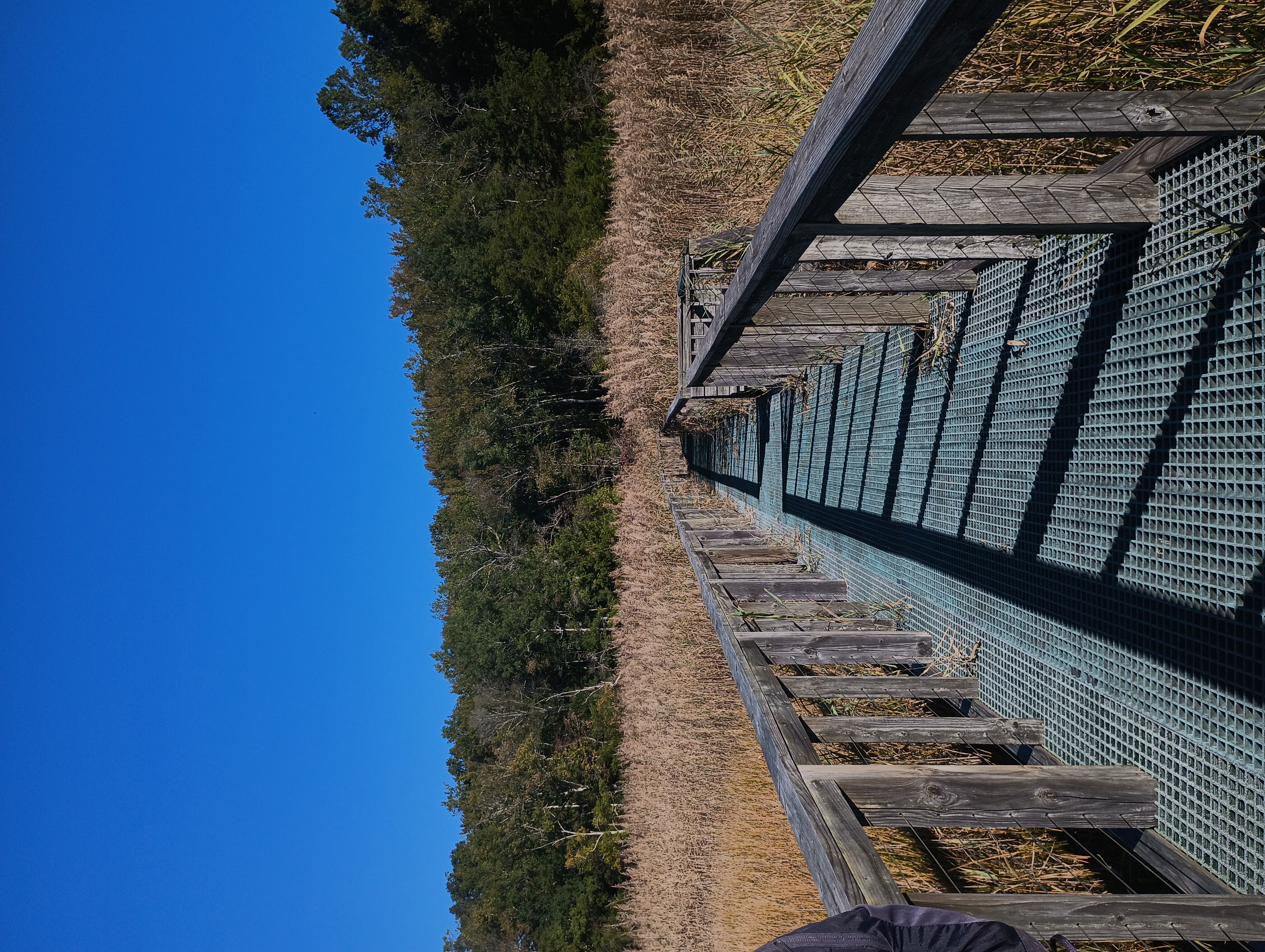Event name: SERC
October 4th, 2025 at SERC Edgewater, MD

Image 1: Marsh boardwalk to Hog Island in the field of phragmites.
On the morning of October 4th, 2025, I woke up to walk to the North Centerville lobby with the meetup time of 8am. After getting together with a group of 7 other students, Dr. Holtz, and Dr. Merck we
headed off Edgewater, MD in a little white van, which I was surprised by. Driving there, Dr. Holtz took the wheel while most of the students were slowly waking up or just quest from the early hours. I spent most of my time looking out the window. I saw horses and plant nurseries, along with a rooster statue in front of a shop. The sights I saw made me realise how close we are to the more rural
suburbs. And upon further thought, it can be seen how much civilization has occupied the natural environments. This became more apparent once we went closer and closer to the Smithsonian Environmental Research
Center(SERC) where the only buildings or structures were for research. It felt nice to be out in nature without as many human-made objects as my day-to-day life. Once we parked, we sat at the France-Merrick Pavilion at the Reed Education Center. There, the volunteers gave us a brief introduction and the overview of the day to be. We would be heading to two main
activities: seining and looking through artificial oyster reefs/clusters. There would be walks along the way where parts of the SERC area would be pointed out to understand more about the location’s history
and usage. Before we left to do the activities, the volunteers led us inside the Reed Education Center where they stayed. We placed our belongings down and looked around the building a bit as many animals were present
for studies and as ambassadors. There were two big tanks with fish and a variety of organisms from previous seining done. There were also 3 terrapins in various tanks with most of the others being
crabs, bugs, or insects. The center had so much information on each organism labeled for the public to see. After exploring, we grouped up to introduce ourselves individually with studies and aspirations from students and experience and studies by volunteers. With introductions out of the way, we all made it outside to
walk through the SERC trail with volunteers stopping to point things out. The first stop was in an opening in the forest with some benches. A volunteer called attention to the study on trees with one example being the measurement of girth with a metal band. This band is a dendrometer which
allows a more consistent measurement of tree diameter as the volunteer pointed out that “breast height” is not the same for everyone. These dendrometers are placed at the same height and
used to measure changes in the diameter of trees depending on the day, season, year, or even hour according to the SERC website. The use of dendrometers has been taking place since 2009 with
expansion by the Forest Ecology Lab to other projects like the Smithsonian Forest Global Observatory(ForestGEO). ForestGEO is a network of research sites and researchers around the world that work with institutions to find out local changes and global trends. These are used to see the impact of changing landscapes and climate
change to help with predictions of the future of forest but also beyond. This research connects with the community through participation with local institutions, but also through their
website where the general public can find out more about the ForestGEO sites and their data around the world. The second stop was near the water where a fallen tree uncovered a Midden from the Piscataway people. One of the volunteers explained that the Piscataway people would eat their food and have remains which they would
place into piles. From the Midden I saw, I could see they(especially the local group) had a diet that was heavy on seafood like clams which makes sense considering the close proximity of
the group to bodies of water. The next stop was on the way to the Marsh Boardwalk to Hog Island. One of the volunteers pointed out a spicebush which the piscataway people used as an insect repellent and tea as it apparently should have a cinnamon
hint to it. This adds to another plant I know that can be eaten/used which I find interesting. Piscataway people and other natives would have done some foraging which people of modern day
generally don’t. This information seems valuable, but not known which feels like the generations are losing more and more connection to being in nature. The volunteers also mention the symbiosis of trumpet vines and poison ivys on trees which provide food for many animals in the canopy like hummingbirds when their flowers bloom. There were other plants volunteers mentioned
in the marshes that I could not catch on as I couldn’t discern them from each other. But, nonetheless, it was very interesting to hear the various plants and organisms along the hike to
different parts of the SERC environment. When we came to an opening, we were met with the Marsh Boardwalk overseeing Fox Creek. There, we went around an octagon area of the boardwalk frequented by otters. The volunteers let us know of a study on otter scat(poop)
where samples are collected and the scat is burned away to reveal things that otters have eaten including certain parasites. This study on River otters and parasites is made possible by the poor hygiene of otters while they eat as they are playful animals. Sometimes, otters eat prey that are covered in parasites that just pass through their
digestive system as these parasites don’t infect the otter at all, as it seems to scientists that mammalian parasites would just directly infect the host. The behavior of these river otters while
consuming prey with parasites allows for the understanding of the environment’s health and detecting threats in the environment. In addition, the consuming of parasites also benefits
the general environment as apex predators. This study is done locally by SERC, but river otters live throughout the east coast so the study on scat can be used to understand the health of
an environment throughout the region or anywhere with river otters. There is also a recently published study on this topic called “North American river otters consume diverse prey and
parasites in a subestuary of the Chesapeake Bay” with the doi: https://doi.org/10.3389/fmamm.2025.1620318. Moving on, we went to the Marsh Boardwalk going to Hog Island where we talked more on the phragmites, a non-native species that have dominated the local marshes. Marshes hold important roles as nurseries, water filters,
and riparian buffers against erosion of communities. The use of phragmites originated as packing material, but ended up in the marshes at the SERC. This plant, although technically invasive,
has become part of the environment by bringing the marshes up higher and preventing erosion from tides and rising global waters. This indirect human effect has brought a dominating
species that actually integrated itself to be somewhat useful to the ecosystem by negating some effects of climate change. After walking back to the Reed Education Center, we put on waders to go seining. The volunteers first taught us how to set up in 3 areas then the process of seining. Each of the 3 areas: rocky with trees, shade, and open
waters, had 4 containers for: jellies, crustations, swimmers, and floaters. Then the seining nets were brought out with a demonstration: 1) the shorter partner would wade out to waist deep,
2)unravel the net and stand apart with good tension, 3)the net should be parallel to the shore, and 4) at a 45° angle, tap the bottom all the way to the shore before lifting up.
After capturing the organisms, place them into their respective containers with wet hands to analyse them. We saw kili fish, grass shrimp, naked golbys, silversides, minnows, and tons of jellies
in our seining containers. The last activity didn’t require waders so we took them off back at the Reed Education Center. There, we walked towards the dock with containers in a wheel barrow and a sign I held. At the dock, the volunteers briefed us
on the benefits of oyster reefs which provide habitats for various organisms and act as water filters as oysters are filter feeders. The rising temperatures caused by global warming drive
oysters are sensitive to the change in temperatures. Although humans did not directly cause negative impacts on oysters, the global warming caused by humans has indirectly affected
oysters for the worse. SERC has experimental, artificial oyster clusters/reefs in containers submerged and tied to the dock. At our excursion, two were pulled up to find the organisms in the
oyster reef clusters. Digging through the oyster shells, I found several mud crabs, parasites, and a few grass shrimp. I believe someone also found a small fish or it was a big grass shrimp. SERC aims to study issues in the Chesapeake Bay and around the world to discover new methods to protect the environment. They reach out to the community through various methods like youtube/social media, blogs/websites,
and having an open research center with hiking trails. Youtube and socials like instagram allow for video communication ofconcepts and projects they are working on or want the general
public to know about. Blogs allow for quick posts of current events while their website houses ways to get connected like volunteering, contributing to data, or just looking through data
on a study. The hiking trains allow for connection to the environment but also information at certain points with boards or centers, and ways to interact with changes like uploading a photo
of the same spot taken by different people. Another method for outreach includes partnering with institutions like colleges and other campuses to expand reach and gain valuable volunteers.
SERC also has programs available for k-12 like field trips or excursions like the one we went on. I would say these methods of community outreach are effective as they bring in
people of various ages, backgrounds, and aspirations. They also use a variety of communication which ensures that everyone has a method of getting information that works the best for them like
a youtube video explaining the study on River otter scat or BiodiverseTree. Social media and blogs also allow for quick information transmission which can help with getting information out to a community.
The use of excursions and field trips also help with outreach as it provides
exposure to the centre to get more people to know it and its purpose.


